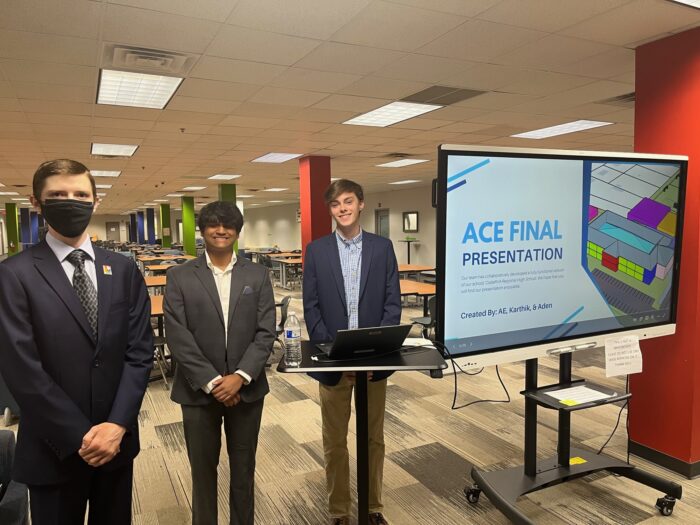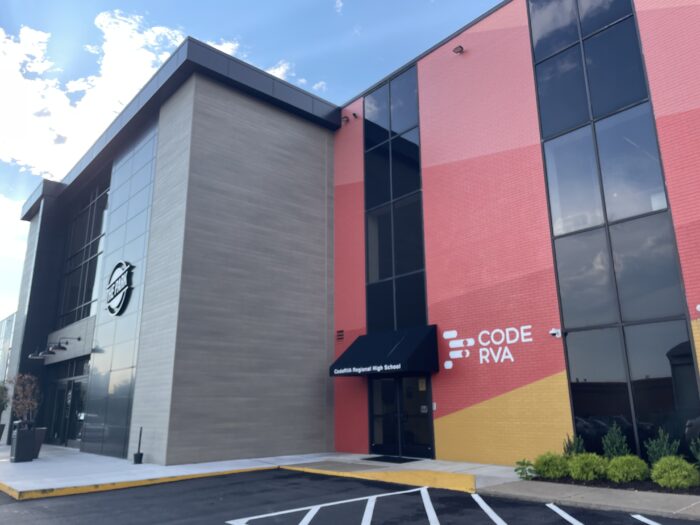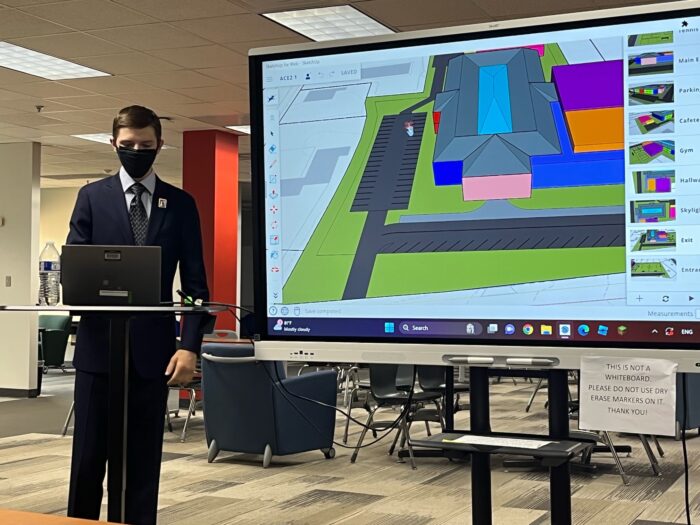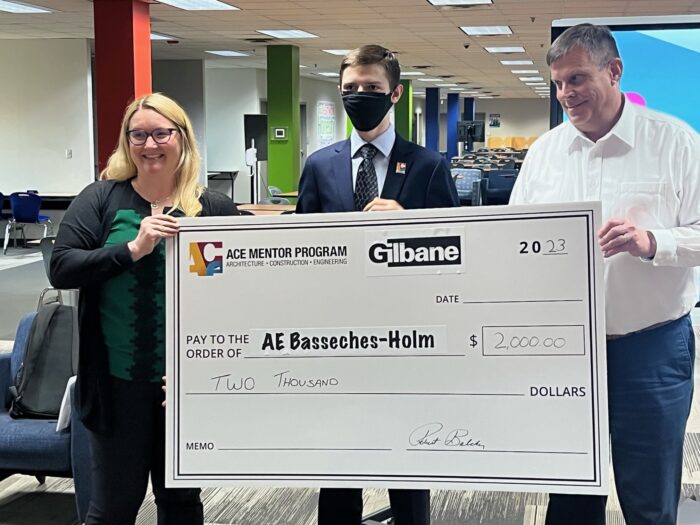
From right: The team of Aden Alexander, Karthik Arumilli and Adam Edward Basseches-Holm. (Photos courtesy CodeRVA)
Three students walked into an end-of-semester presentation. They had devised an architectural plan to replace their school. No small order. How about some background?
CodeRVA Regional High School has 360 students who arrive each school day from 15 cities and counties stretching from Sussex to Goochland counties. It’s like the iconic “jizz” cantina scene in “Star Wars”; travelers from disparate galaxies converge and hit their instruments. The public, four-year specialty school for computer science and coding is located near The Diamond at 1405 Cummings Drive. It was established in 2017. Incoming freshmen are selected by lottery (weighted to assure socioeconomic diversity). With no scores, admission tests, essays or letters of recommendation, its racially diverse student body reflects the region the school serves: 46 percent white, 40 percent African American or Black, 10 percent Latino, 5 percent Asian, and 9 percent mixed race.
Most students arrive and depart by yellow school bus (routes and vehicles are shared with the regional Maggie L. Walker Governor’s School for Government and International Studies, located nearby). CodeRVA students fulfill their required core courses in the ninth and 10th grades and during the final years focus on internships to prepare them for college or technical positions in the workplace. According to school officials, Virginia has 36,000 unfilled computer science-related positions. The goal is to give students real-world experience, racking up a minimum of 360 hours of practical integrated technology work. Many seniors graduate with associate degrees from community college. This year, 100 percent of the senior class graduated on time.
“I wanted to do something different for high school,” says Aden Alexander, 17, a rising senior from rural New Kent County. He arrived at CodeRVA as a freshman in 2020 amid COVID-19 restrictions, when online classes were standard. He had envisioned a career in engineering, but with no computer science or coding experience, in his first year he took an advanced placement course in computer science principles. “I loved it instantly,” he says of the school, which just completed its fifth year of operation. “The students want to learn and the teachers are the finest you will ever find.”
Alexander’s practical work experience thus far has included an internship this past school year with Gilbane Building Company. One of the construction projects to which Gilbane assigned him was the just-completed Virginia General Assembly Building overlooking Capitol Square. Using software programs, he accompanied contractors, and architects from Glave & Holmes Architecture, on punch walks to inspect finishing touches and furnishing installations. “It was time-consuming as we recorded things like funny paintwork, nicks and chips, and inconsistencies,” Alexander says. “You have to have high expectations.” His planned four-week internship extended for a number of weeks beyond that. “It was life-changing,” he says, citing his on-the-job mentors and CodeRVA staff who helped him secure the opportunity.

CodeRVA is located inside the Michael & Son building near The Diamond, next to the Park RVA entertainment venue.
CodeRVA’s digs aren’t fancy. The high school rents space in a midcentury modern Michael & Son building that formerly housed the A.H. Robins Inc. pharmaceutical company. The physical heart of the school is an open and cavernous “flex” space in the center of the main floor. It is distinguished by rows of pier columns painted red and green. Dozens of folding tables are either aligned or clustered, as needed to serve the needs of the moment. Traditional classrooms open onto this sprawling room. There are no athletics, but students may participate in their respective home school teams. There are extracurricular activities, however. In some years there’s been a student architecture club, but for the past two years an after-school program, lasting from 18 to 20 weeks, has been offered to those interested in the fields of architecture, construction and engineering. It is sponsored by ACE Mentor Program RVA, an extension of a national effort aimed at sparking creativity in students and perhaps inspiring some to follow a career in, well, architecture, construction or engineering.
“We walk them through the entire process of a building project, site considerations, the financial side, landscapes, design, building diagrams, and floor plans with three-dimensional overlays showing electricity, mechanical systems and plumbing,” says Jason Hendricks, an architect with HDR, Inc., who spent many Wednesday afternoons this past year at CodeRVA. His fellow ACE volunteer colleagues were architect Charles Selden of Cornerstone Architects and structural engineers Shelton Fraher and Andrew Woods. “We are trying to hit a niche in the community,” Hendricks says of taking an introduction to the building field into a public school.
While a dozen CodeRVA students participated in the ACE after-school program earlier the year, by year’s end three students, including Aden Alexander, presented the capstone program on May 11 (staying after school is a problem for bus riders, thus the attrition). But Alexander and fellow juniors, Karthik Arumilli of Henrico County and Adam Edward Basseches-Holm (who goes by “AE” and lives in Richmond’s Fan District) entered the school’s “flex” space, where peers, family, educators and their mentors awaited. The boys looked sharp in collared shirts and sport coats. Their yearlong project was the design for a hypothetical high school. Since CodeRVA has reached student capacity at its present location in a repurposed office building, it is contemplating a move. There is no timetable. The school’s executive director, Kume Goranson, a dynamic, 20-year veteran of Chesterfield County public schools, says that a central, perhaps downtown, Richmond location would be ideal (and not far from Maggie Walker for transportation efficiencies).
As to the school’s design, why not ask some authorities – students – how a new facility might look and function?
“Definitely, being students we had unique insights into what we wanted changed,” says Basseches-Holm, 17, a few weeks after the presentation. His interest in construction and architecture was fostered in middle school by robotics projects. “Since our school doesn’t have many windows now, Aden, Karthik and I wanted to bring in natural light with windows and skylights. We also don’t have spaces for athletics and our school needs an auditorium and a larger cafeteria.”
After examining multiple possible locations for their envisioned school, the students got a suggestion from Hendricks to consider a thickly wooded, 6-acre tract in Richmond on Cherokee Road. It’s in the Southampton neighborhood. Clearly not a center city location, but the students jumped right in. “We decided to keep the foliage around the perimeter of the property, to keep the site as green as possible and brighten up the site with more landscaping,” Alexander says. “We considered adding an access road to the complex but decided against it since we figured the residential neighborhood wouldn’t appreciate it.” The team gave considerable thought to parking and optimal spaces for buses. For the building, the students stayed true to their school by devising a floor plan that paid homage to the current “flex” space.
In preparing the presentation, each of the three students played to individual strengths. Arumilli took the lead in the overall design. The project specified mass timber construction; large, composite wooden beams that have a low carbon footprint (they were inspired by a new structure at Virginia Military Institute). Basseches-Holm dealt with physical aspects of the project, such as landscaping, three-dimensional modeling as well as researching city codes and regulations regarding sidewalks and parking. Alexander, whom his classmates considered strong in communications, focused on logistics and organized the final presentation and its visuals.
“They were professional, a small and hearty group,” CodeRVA’s Goranson said of the presentation. “One of the things I really appreciated was the timber design plus the fact that the students wanted natural light, and wanted to keep the open floor plan [reflecting what we have now]. And how lovely that the students put in a courtyard to allow people to sit outside and a space the community might use.”
Neither Alexander, Arumilli nor Basseches-Holm expressed career interest in architecture, but Basseches-Holm said that he may major in engineering, and since participating in the ACE program, will minor in architecture. But count on them all, as CodeRVA graduates, to be paying close attention to the architectural design of a possible new school at alumni functions.

From right: The team of Aden Alexander, Karthik Arumilli and Adam Edward Basseches-Holm. (Photos courtesy CodeRVA)
Three students walked into an end-of-semester presentation. They had devised an architectural plan to replace their school. No small order. How about some background?
CodeRVA Regional High School has 360 students who arrive each school day from 15 cities and counties stretching from Sussex to Goochland counties. It’s like the iconic “jizz” cantina scene in “Star Wars”; travelers from disparate galaxies converge and hit their instruments. The public, four-year specialty school for computer science and coding is located near The Diamond at 1405 Cummings Drive. It was established in 2017. Incoming freshmen are selected by lottery (weighted to assure socioeconomic diversity). With no scores, admission tests, essays or letters of recommendation, its racially diverse student body reflects the region the school serves: 46 percent white, 40 percent African American or Black, 10 percent Latino, 5 percent Asian, and 9 percent mixed race.
Most students arrive and depart by yellow school bus (routes and vehicles are shared with the regional Maggie L. Walker Governor’s School for Government and International Studies, located nearby). CodeRVA students fulfill their required core courses in the ninth and 10th grades and during the final years focus on internships to prepare them for college or technical positions in the workplace. According to school officials, Virginia has 36,000 unfilled computer science-related positions. The goal is to give students real-world experience, racking up a minimum of 360 hours of practical integrated technology work. Many seniors graduate with associate degrees from community college. This year, 100 percent of the senior class graduated on time.
“I wanted to do something different for high school,” says Aden Alexander, 17, a rising senior from rural New Kent County. He arrived at CodeRVA as a freshman in 2020 amid COVID-19 restrictions, when online classes were standard. He had envisioned a career in engineering, but with no computer science or coding experience, in his first year he took an advanced placement course in computer science principles. “I loved it instantly,” he says of the school, which just completed its fifth year of operation. “The students want to learn and the teachers are the finest you will ever find.”
Alexander’s practical work experience thus far has included an internship this past school year with Gilbane Building Company. One of the construction projects to which Gilbane assigned him was the just-completed Virginia General Assembly Building overlooking Capitol Square. Using software programs, he accompanied contractors, and architects from Glave & Holmes Architecture, on punch walks to inspect finishing touches and furnishing installations. “It was time-consuming as we recorded things like funny paintwork, nicks and chips, and inconsistencies,” Alexander says. “You have to have high expectations.” His planned four-week internship extended for a number of weeks beyond that. “It was life-changing,” he says, citing his on-the-job mentors and CodeRVA staff who helped him secure the opportunity.

CodeRVA is located inside the Michael & Son building near The Diamond, next to the Park RVA entertainment venue.
CodeRVA’s digs aren’t fancy. The high school rents space in a midcentury modern Michael & Son building that formerly housed the A.H. Robins Inc. pharmaceutical company. The physical heart of the school is an open and cavernous “flex” space in the center of the main floor. It is distinguished by rows of pier columns painted red and green. Dozens of folding tables are either aligned or clustered, as needed to serve the needs of the moment. Traditional classrooms open onto this sprawling room. There are no athletics, but students may participate in their respective home school teams. There are extracurricular activities, however. In some years there’s been a student architecture club, but for the past two years an after-school program, lasting from 18 to 20 weeks, has been offered to those interested in the fields of architecture, construction and engineering. It is sponsored by ACE Mentor Program RVA, an extension of a national effort aimed at sparking creativity in students and perhaps inspiring some to follow a career in, well, architecture, construction or engineering.
“We walk them through the entire process of a building project, site considerations, the financial side, landscapes, design, building diagrams, and floor plans with three-dimensional overlays showing electricity, mechanical systems and plumbing,” says Jason Hendricks, an architect with HDR, Inc., who spent many Wednesday afternoons this past year at CodeRVA. His fellow ACE volunteer colleagues were architect Charles Selden of Cornerstone Architects and structural engineers Shelton Fraher and Andrew Woods. “We are trying to hit a niche in the community,” Hendricks says of taking an introduction to the building field into a public school.
While a dozen CodeRVA students participated in the ACE after-school program earlier the year, by year’s end three students, including Aden Alexander, presented the capstone program on May 11 (staying after school is a problem for bus riders, thus the attrition). But Alexander and fellow juniors, Karthik Arumilli of Henrico County and Adam Edward Basseches-Holm (who goes by “AE” and lives in Richmond’s Fan District) entered the school’s “flex” space, where peers, family, educators and their mentors awaited. The boys looked sharp in collared shirts and sport coats. Their yearlong project was the design for a hypothetical high school. Since CodeRVA has reached student capacity at its present location in a repurposed office building, it is contemplating a move. There is no timetable. The school’s executive director, Kume Goranson, a dynamic, 20-year veteran of Chesterfield County public schools, says that a central, perhaps downtown, Richmond location would be ideal (and not far from Maggie Walker for transportation efficiencies).
As to the school’s design, why not ask some authorities – students – how a new facility might look and function?
“Definitely, being students we had unique insights into what we wanted changed,” says Basseches-Holm, 17, a few weeks after the presentation. His interest in construction and architecture was fostered in middle school by robotics projects. “Since our school doesn’t have many windows now, Aden, Karthik and I wanted to bring in natural light with windows and skylights. We also don’t have spaces for athletics and our school needs an auditorium and a larger cafeteria.”
After examining multiple possible locations for their envisioned school, the students got a suggestion from Hendricks to consider a thickly wooded, 6-acre tract in Richmond on Cherokee Road. It’s in the Southampton neighborhood. Clearly not a center city location, but the students jumped right in. “We decided to keep the foliage around the perimeter of the property, to keep the site as green as possible and brighten up the site with more landscaping,” Alexander says. “We considered adding an access road to the complex but decided against it since we figured the residential neighborhood wouldn’t appreciate it.” The team gave considerable thought to parking and optimal spaces for buses. For the building, the students stayed true to their school by devising a floor plan that paid homage to the current “flex” space.
In preparing the presentation, each of the three students played to individual strengths. Arumilli took the lead in the overall design. The project specified mass timber construction; large, composite wooden beams that have a low carbon footprint (they were inspired by a new structure at Virginia Military Institute). Basseches-Holm dealt with physical aspects of the project, such as landscaping, three-dimensional modeling as well as researching city codes and regulations regarding sidewalks and parking. Alexander, whom his classmates considered strong in communications, focused on logistics and organized the final presentation and its visuals.
“They were professional, a small and hearty group,” CodeRVA’s Goranson said of the presentation. “One of the things I really appreciated was the timber design plus the fact that the students wanted natural light, and wanted to keep the open floor plan [reflecting what we have now]. And how lovely that the students put in a courtyard to allow people to sit outside and a space the community might use.”
Neither Alexander, Arumilli nor Basseches-Holm expressed career interest in architecture, but Basseches-Holm said that he may major in engineering, and since participating in the ACE program, will minor in architecture. But count on them all, as CodeRVA graduates, to be paying close attention to the architectural design of a possible new school at alumni functions.

